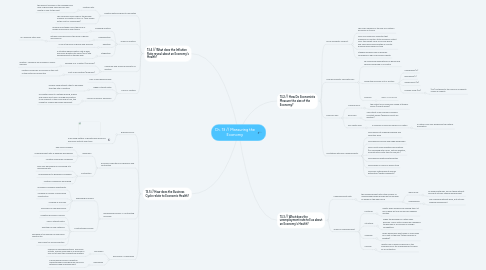
1. 13.4 // What does the Inflation Rate reveal about an Economy's Health?
1.1. Inflation Rate and how its calculated
1.1.1. Inflation rate:
1.1.1.1. the percent increase in the average price level of goods and services from one month or year to the next.
1.1.2. The consumer price index is the primary measure of inflation in the U.S. (also known as the cost-of-living index)
1.2. Types of Inflation
1.2.1. Creeping Inflation
1.2.1.1. gradual and steady rise in the price of goods and services over timme
1.2.2. Hyperinflation
1.2.2.1. extreme and rapid rise in the price of goods and services
1.2.2.1.1. ex. Germany after WWI
1.2.3. Deflation
1.2.3.1. A fall in the price of goods and services
1.2.4. Stagflation
1.2.4.1. a situation where inflation rate is high, economic growth rate slows (GDP) and unemployment is steadily high
1.3. Consumer and Producer impacts on inflation
1.3.1. Demand-Pull Inflation (consumer)
1.3.1.1. inflation caused by an increase in overall demand
1.3.2. Cost-Push Inflation (producer)
1.3.2.1. inflation caused by an increase in the cost of the factors of production
1.4. Cons of Inflation
1.4.1. Loss of Purchasing Power
1.4.2. Higher Interest Rates
1.4.2.1. lenders need interest rates to be higher than the rate of inflation
1.4.3. Loss of Economic Efficiency
1.4.3.1. as inflation leads to unstable pricing, buyers and sellers don't have enough information to be efficient in their roles and in turn, the market as a whole becomes inefficient
2. 13.5 // How does the Business Cycle relate to Economic Health?
2.1. Business cycle:
2.1.1. a recurring pattern of growth and decline in economic activity over time.
2.2. economic indicators of expansion and contraction
2.2.1. expansion
2.2.1.1. Real GDP increases
2.2.1.2. Unemployment Rate is generally decreasing
2.2.1.3. Inflation is generally increasing
2.2.2. contraction
2.2.2.1. Real GDP decreasing or increasing at a decreasing rate
2.2.2.2. Unemployment is generally increasing
2.2.2.3. Inflation is generally decreasing
2.3. Expanding economy v. Contracting economy
2.3.1. expanding economy
2.3.1.1. increase in buisness investments
2.3.1.2. increase in number of new home constructon
2.3.1.3. increase in real GDP
2.3.1.4. Discovery of New Resources
2.3.2. Contracting Economy
2.3.2.1. Negative Economic Shocks
2.3.2.2. rise in Interest Rates
2.3.2.3. Shortage of Raw Materials
2.3.2.4. Decrease in the number of new home constructon
2.3.2.5. Firms hold too much inventory
2.4. Recession v. Depression
2.4.1. Recession
2.4.1.1. a period of declinging national economic activity, usually measured as a decrease in GDP for at least two consectuve quarters
2.4.2. Depression
2.4.2.1. a prolonged economic downturn characterized by plunging real GDP and extremely high unemployment.
3. 13.2 // How Do Economists Measure the size of the Economy?
3.1. Gross Domestic Product:
3.1.1. The main measure of the size of a nation's economy is its GDP
3.1.2. GDP is an economic indicator that measures a country's total economic output GDP: the market value of all final goods and services produced within a country during a given period of time
3.1.3. Steadily growing GDP is generally considered a sign of economic health
3.2. How Economists Calculate GDP
3.2.1. By measuring expenditures on goods and services produced in a country
3.2.2. Divide the economy into 4 sectors:
3.2.2.1. Households (C)
3.2.2.2. Buisnesses (I)
3.2.2.3. Government (G)
3.2.2.4. Foreign Trade (NX)
3.2.2.4.1. (NX) Net Exports: the value of all exports minus all imports
3.2.3. Formula:
3.2.3.1. GDP= C+I+G+NX
3.3. Types of GDP
3.3.1. Nominal GDP:
3.3.1.1. the output of an economy valued at today's prices (current dollars)
3.3.2. Real GDP:
3.3.2.1. The output of an economy valued in constant dollars (which accounts for inflation)
3.3.3. Per Capita GDP:
3.3.3.1. A measure of GDP per person in a nation
3.3.3.1.1. a nation's real GDP divided by the nations population
3.4. Limitations with GDP measurements
3.4.1. GDP leaves out unpaid household and volunteer work
3.4.2. GDP ignores informal and illegal exchanges
3.4.3. GDP counts some negatives as positives (ex. rebuilding after WWII, natural disasters, reconstruction after the civil war,etc.)
3.4.4. GDP ignores negative externalities
3.4.5. GDP places no value on leisure time
3.4.6. GDP says nothing about income distribution (spatial inequality)
4. 13.3 // What does the unemployment rate tell us about an Economy's Health?
4.1. Unemployment Rate
4.1.1. the unemployment rate is the number of unemployed people divided by the number of people in the labor force
4.1.1.1. labor force:
4.1.1.1.1. all people with jobs, and all those without work but actively seeking employment
4.1.1.2. unemployed
4.1.1.2.1. any individual without work, but actively seeking employment
4.2. Types of unemployment
4.2.1. Frictional
4.2.1.1. results when workers are seeking their 1st job or have left one job and are seeking another
4.2.2. Structural
4.2.2.1. When the demand for certain skills declines. This is often caused by changes in technology or an increase in foreign competition.
4.2.3. Seasonal
4.2.3.1. When businesses shut down or slow down for a part of the year (often because of weather)
4.2.4. Cyclical
4.2.4.1. results from a period of decline in the business cycle; its unemployment caused by a contraction
